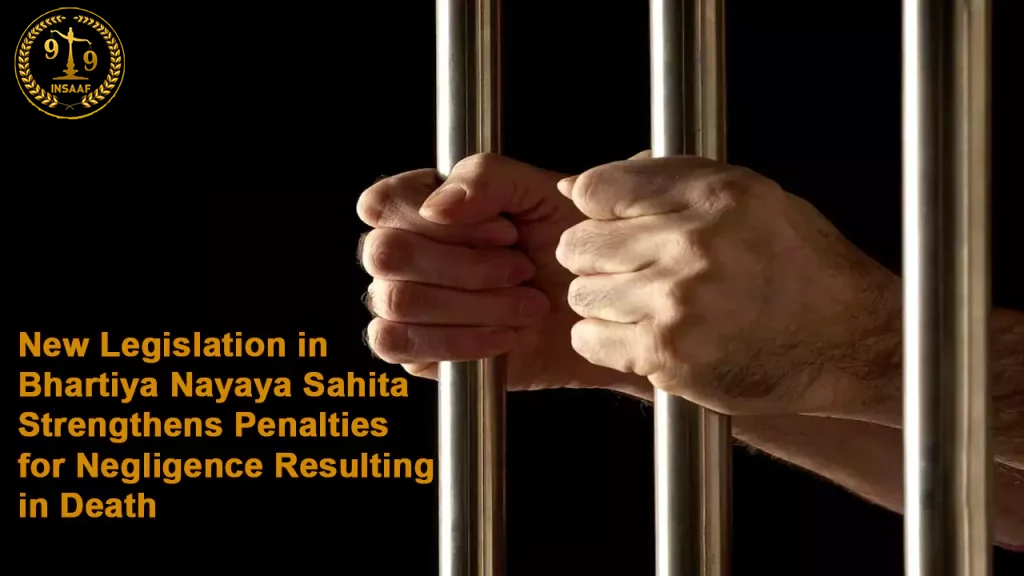

Online Legal Advice from Insaaf99® Online Lawyer Consultation in India


Online Legal Advice from Insaaf99® Online Lawyer Consultation in India

The newly introduced Bhartiya Nyaya Sanhita (BNS) has made substantial alterations to India's legal framework, with Section 106 drawing notable attention, particularly concerning road accidents. A major amendment, the Bhartiya Nayaya Sahita, has instituted more stringent measures to address cases of causing death by negligence. Section 106 delineates the penalties for such offenses, striving to augment accountability and act as a deterrent. This article explores the ramifications of this pivotal section, assessing its potential effects on hit-and-run incidents and posing essential questions for in-depth discussion.
According to Section 106, individuals found guilty of causing death by negligence may face imprisonment for up to 5 years. This provision is a crucial step towards ensuring justice for victims and their families, as it holds those responsible for negligence accountable for their actions.
Causing Death by Rash or Negligent Driving: This now entails a maximum imprisonment of five years, coupled with a fine. Notably, this represents a substantial increase from the previous two-year limit set by the Indian Penal Code (IPC) Section 304A, which Section 106 replaces.
Hit-and-run Causing Death: The true strength of this section lies in its focus on hit-and-runs. If a driver "escapes without reporting it to a police officer or a Magistrate soon after the incident," the punishment can escalate to a significant ten years in prison along with a fine. This heightened penalty is aimed at deterring the prevalent practice of fleeing accident scenes, a behavior that often leaves families in distressing uncertainty and hampers investigative efforts.
Addressing Death By Negligence in Medical Practice: In cases where negligence occurs during a medical procedure and involves a medical practitioner, the consequences are even more severe. The legislation specifies that such medical practitioners could be subject to imprisonment for a term extending up to 2 years, in addition to a liable fine. This provision emphasizes the importance of maintaining a high standard of care within the medical profession, highlighting the gravity of negligent actions during medical procedures.

Supporters of the section contend that it conveys a resolute stance of zero tolerance toward hit-and-runs. This could potentially yield several advantages:
Increased Reporting: Drivers may be more inclined to report accidents, given the severe consequences associated with fleeing the scene.
Improved Investigations: Timely reporting facilitates enhanced evidence collection and witness testimonies, contributing to expedited justice for victims.
Deterrence of Reckless Driving: The heightened penalties might serve as a deterrent, encouraging drivers to exercise greater caution on the roads.
Potential Impact on Medical Negligence Cases: BNS Section 106 if applied to medical professionals whose actions, or lack thereof, during a procedure result in a patient's death. This could serve as a deterrent against avoidable medical errors and encourage stricter adherence to standard protocols.
However, certain apprehensions have surfaced:
Misuse of the Law: Concerns exist about the potential misuse of this section for false accusations or targeting specific individuals. Establishing robust legal safeguards and ensuring fair investigation procedures becomes crucial to prevent such exploitation.
Impact on Drivers: The prospect of a ten-year sentence may instill unwarranted fear and anxiety among drivers, particularly those involved in unintentional accidents. Striking a balance between accountability and fairness becomes imperative.
Implementation Challenges: Effective implementation hinges on well-trained police personnel, appropriate infrastructure, and streamlined investigation processes. Ensuring proper resource allocation and capacity building is necessary for successful execution.
Medical Negligence vs. Medical Error: Differentiating between genuine errors in judgment and deliberate negligence is essential. Well-established medical guidelines and expert opinions can help determine the presence of negligence.
BNS Section 106 addresses hit-and-runs with undeniable benefits, but its equitable implementation demands careful monitoring. Applying it to medical negligence cases necessitates nuanced dialogue involving legal experts, medical professionals, and the public. Unlike hit-and-runs, medical negligence lacks an intent to evade responsibility, often stemming from unforeseen complications in a high-pressure environment. To prevent legal issues, promoting transparency and open communication between healthcare providers and patients is vital.
Insaaf99, an online legal consultation platform, plays a crucial role in BNS cases by connecting individuals with expert legal professionals. For BNS-related issues, users can find specialized lawyers who understand the nuances of the new legislation. The platform facilitates seamless communication, ensuring timely advice and representation. Whether dealing with hit-and-run cases or medical negligence, Insaaf99 serves as a reliable resource, offering legal advice and support tailored to the specific intricacies of BNS.
The Bhartiya Nayaya Sahita, by introducing these comprehensive measures, aims to create a legal framework that ensures accountability for negligent actions leading to loss of life. The legislation seeks to strike a balance between deterrence and rehabilitation, acknowledging the severity of the offenses while upholding principles of justice. It is expected that these new provisions will contribute to a safer society by discouraging negligent behavior and holding individuals accountable for their actions resulting in the loss of human life.